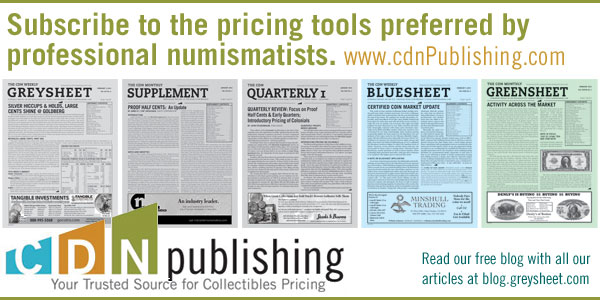
PREV ARTICLE
NEXT ARTICLE
FULL ISSUE
PREV FULL ISSUE
TO DIGITIZE OR NOT TO DIGITIZE
Paul Gilkes of Coin World published a blog article on February 1, 2016 about digitizing numismatic publications. Len Augsburger
and I were quoted. Here's an excerpt. -Editor
To digitize or not digitize, that is the question. At the forefront of efforts to digitize printed numismatic works to subsequently make available free for numismatic research, are the American Numismatic Society and the Newman Numismatic Portal. The Newman Numismatic Portal is an educational outreach initiative of the Eric P. Newman Numismatic Educational Society. The ANS has been focused on digitizing references and other numismatic literature on ancient and world numismatic subjects along with auction catalogs to which researchers, collectors and others with interest would otherwise not have access. The Newman Numismatic Portal is also digitizing major numismatic references that have been out-of-print for decades, auction catalogs, as well as periodicals of specialty collector clubs who have granted permission for digitization. The subject of whether to digitize the printed word was broached during a January meeting of a specialty collector club. The question was raised about whether permission should be granted for carte-blanche digitization of all club publications, or if there should be any restrictions. Opinions were also raised as to whether allowing digitization would affect club membership. Also posed was the effects digitization of original vintage numismatic references would have on the value of printed copies held by collectors. And some authors of numismatic works published in recent years wondered the effect digitization would have on their efforts to profit from their works or at the least, recoup their costs. I reached out to two numismatic bibliophiles, Wayne Homren, and Len Augsburger, to weigh in with their opinions on the subject. Both work closely with the Newman Numismatic Portal. Wayne is also editor of The E-Sylum, the weekly electronic newsletter of the Numismatic Bibliomania Society. Augsburger is an NBS governor. “I view digitization as a tool which enhances print,” says Augsburger. “Being able to search a large group of documents brings additional value to a physical library. It’s fine to have a complete run of The Numismatist, but unless you can search it some of the value is lost. In many cases you might search on something and then go retrieve the physical copy for easier access. For research purposes, physical copies are often easier to work with. One can flip through an auction catalog much faster than viewing individual lots online.” Augsburger said he doesn’t view digitization as detrimental to printed copies. “The American Journal of Numismatics (first series, 1866-1924) has been online for years, and printed copies still trade actively. To use a more extreme example, a physical copy of the Gutenberg bible, or a Dunlap printing of the Declaration of Independence, remain extraordinarily valued documents, even though digital copies are available.” Augsburger explains the Newman Numismatic Portal is working on a solution for text search of in-copyright documents. NNP has also digitized back issues of collector club journals, including those of the Liberty Seated Collectors Club and NBS. “Keeping current subscribers engaged is an understandable concern, so most organizations [will] hold back the last two to three years of issues from digitization,” Augsburger said. “Organizations need to have subscribers to produce content in the first place, so protecting the subscriber base is a completely reasonable concern.” Homren said numismatic book dealer David Fanning related in a recent interview that references in top physical condition [or those with fine bindings or] author signatures or collector annotations will retain or increase their value despite digitization. “Contemporary broadsides, pamphlets, catalogs and periodicals are a tangible link to numismatic history, and are often far more rare than the coins they describe. As more and more people recognize these as collectibles in themselves, demand and prices will increase. “I think that in numismatic literature we will see a continuation of the general trend in used and rare books that started with the introduction of the Internet. Common stuff will stagnate or go down in price, but rare items will continue to rise. With greater availability of the information to researchers, there will be more references [to] and more publicity for the rare and interesting items, boosting interest and demand.” Digitization of numismatic literature has assisted me tremendously in my research. To digitize or not to digitize – What do YOU think?
David Fanning was speaking primarily about bindings in the article I had in mind - see the link below. -Editor
To read the complete article, see:
To read the earlier E-Sylum article, see:

Wayne Homren, Editor The Numismatic Bibliomania Society is a non-profit organization promoting numismatic literature. See our web site at coinbooks.org. To submit items for publication in The E-Sylum, write to the Editor at this address: whomren@gmail.com To subscribe go to: https://my.binhost.com/lists/listinfo/esylum All Rights Reserved. NBS Home Page Contact the NBS webmaster 
|